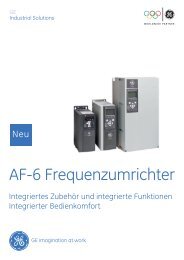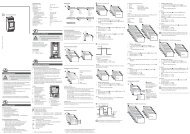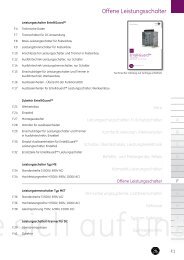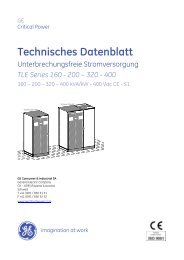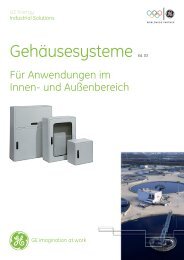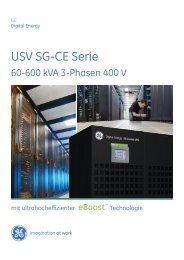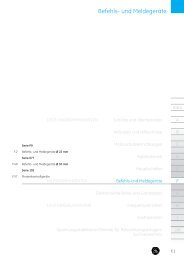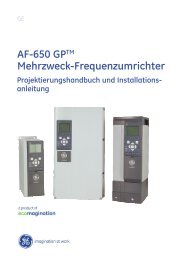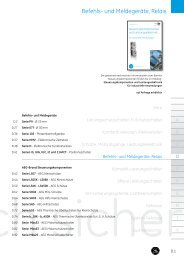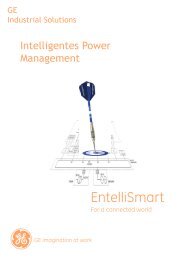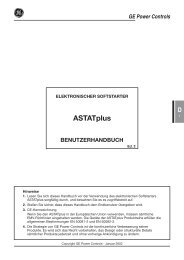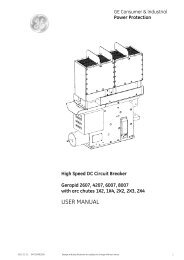Uninterruptible Power Supplies - G E Power Controls
Uninterruptible Power Supplies - G E Power Controls
Uninterruptible Power Supplies - G E Power Controls
Create successful ePaper yourself
Turn your PDF publications into a flip-book with our unique Google optimized e-Paper software.
UPS<br />
STS - Static Transfer Switch<br />
Applications<br />
Order codes<br />
A<br />
B<br />
X<br />
Function<br />
Providing exceptionally reliable<br />
protection for electrical equipment<br />
Standards / Marking<br />
Safety: EN 60950<br />
EMC: EN 50022 level B,<br />
EN 60555-2-3<br />
Static Transfer Switches (STS) are designed to transfer the supply between<br />
two independent AC power sources. Unlike traditional automatic transfer<br />
switches (ATS), a static transfer switch provides a fast load transfer (typically<br />
1/4 of a cycle), which ensures uninterrupted operation of sensitive electronic<br />
equipment. Load retransfer to the preferred input source is virtually<br />
instantaneous (typically 0.1 ms). The basic applications of STS are in automatic<br />
systems in the power industry, power supply systems for petrochemical<br />
industry, computer and telecommunication centres, automatic and security<br />
systems of ‘intelligent’ buildings as well as other equipment which is sensitive<br />
to interruptions in the supply.<br />
Characteristics<br />
The excellent overload capability and transfer algorithm enables fast fuse<br />
clearance in the event of a short-circuit. As a consequence the voltage<br />
immediately returns to normal to supply the other loads. The built-in transient<br />
voltage surge suppression system for SCR switches provides additional<br />
protection against damage to the supplied equipment.<br />
The static transfer switch consists of two bidirectional thyristor switches for<br />
each phase equipped with a control and protection system. The 2 or 4 pole<br />
types have an additional neutral line switch. After failure of the preferred<br />
source, the STS checks the state of the alternate power source and transfers<br />
the load to whichever source provides power within selectable limits. This<br />
transfer can be triggered by disturbance in the preferred source voltage,<br />
overcurrent in the source or manual or remote change of the preferred<br />
source. With both sources in limits and synchronised (phase error within the<br />
acceptable range), manual or remote transfer is performed in less than 200 μs.<br />
Transfers initiated by fault conditions in the preferred source depend on the<br />
status of the alternate source. For synchronised power sources with phase<br />
error within the limits, transfer to an alternate source is made within 6ms delay.<br />
Lack of synchronisation causes delay before transfer. It is possible to set the<br />
delay with dipswitches.<br />
Technical specifications (general)<br />
Nominal input voltage<br />
400 Vac ph-ph / 230 Vac ph-N<br />
Input voltage window nominal -25% +20%<br />
Nominal input frequency<br />
50 Hz<br />
Input frequency range nominal -9% + 6%<br />
Efficiency > 99% at cos phi 0.8<br />
Crest factor acceptance 3.5<br />
<strong>Power</strong> factor (max. cos phi)<br />
0.5 - 1.0 (leading/lgging)<br />
Ambient operating temperature 0 to 40°C<br />
Relative humidity<br />
95% non-condensing<br />
Altitude 1000 m (above 1000 m 5% derating per 500 m; max. 3000 m)<br />
Cooling<br />
redundant cooling fans<br />
Audible noise<br />



